Menu
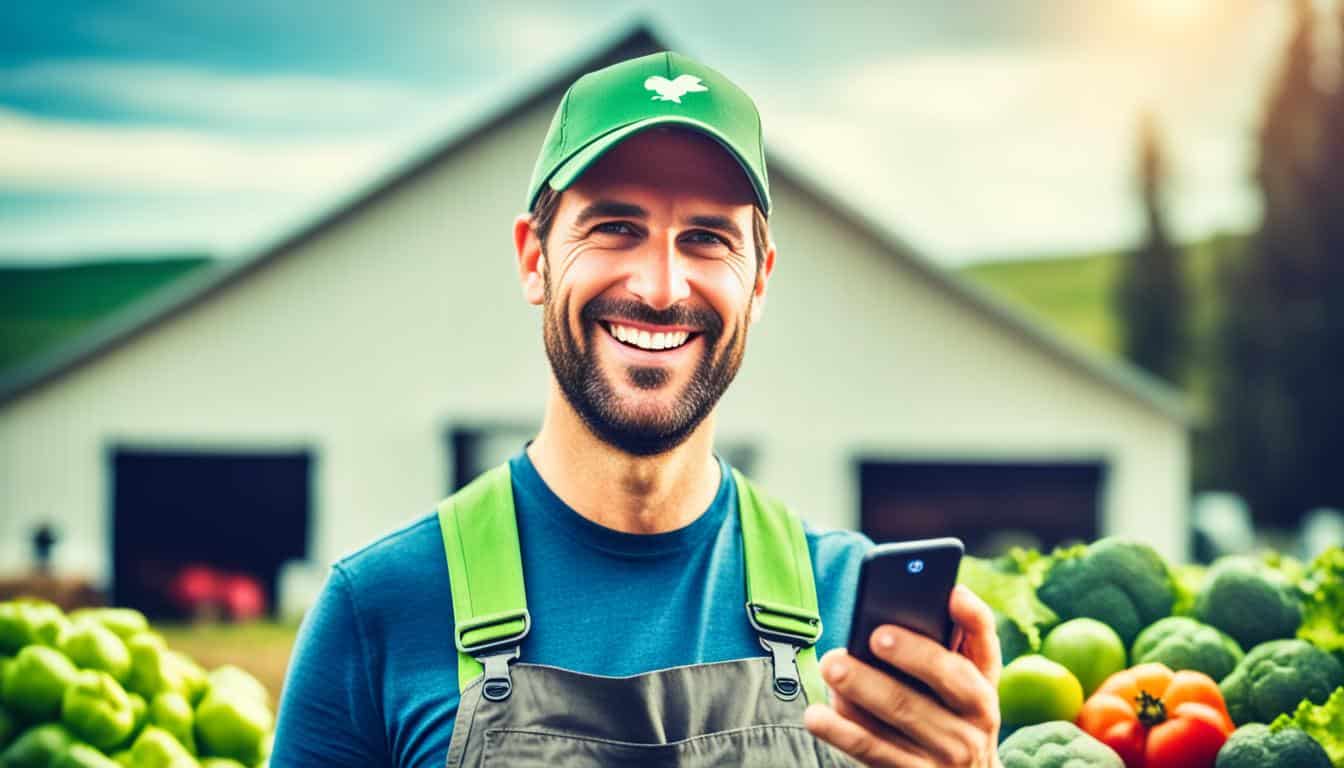
Did you know farmers in South-South Nigeria are making more money thanks to social media? They are using WhatsApp and Instagram to sell their produce better. This change has cut their marketing costs. It shows how powerful social media is for boosting farm sales.
Social media does more than save money. It helps farmers share knowledge and find new customers cheaply. It beats traditional ways of advertising, like newspapers and TV, hands down. Farm sales go up because of this smart move on social media.
A study in Kenya backs this up. It found that the more people interact with farm adverts online, the better these ads perform. And in Iran, it was shown that using technology well can make agriculture sales 57% better.
Using social media smartly doesn’t just help farmers. It can lift up whole communities in poorer countries. By making farming more productive and marketing cheaper, poverty can drop. So, social media is not just a trend. It’s a real game-changer for farming.
Adding social media to farming is now a smart move. It helps farmers reach many people and stay connected. Agricultural social media strategies are crucial for advertising. They are cheaper and let farmers show their goods and talk to buyers. In places like South-South Nigeria, apps like WhatsApp and Instagram are very popular for farming.
A study in South-South Nigeria found using social media cuts marketing costs for farm products. The study used special tests to prove this. Mwangi & Wagoki (2016) found that using social media helps ads perform better.
Other studies showed 57% better farming marketing in Iran thanks to technology. Social media helps make sharing information and marketing more efficient.
These studies show how important social media is for farming. It makes marketing cheaper and more efficient than traditional ways.
“The integration of social media into agriculture has dramatically transformed marketing approaches, offering unprecedented opportunities for cost reductions and enhanced efficiency in reaching consumers.”
Talking directly to customers online is great because they give instant feedback. This makes ads and marketing work better, as shown in the studies.
So, using social media is a must for modern farming. It makes marketing better and helps farms grow.
In conclusion, using social media smartly boosts farm sales. It makes farming more competitive and successful.
Facebook is a key tool in farm marketing because it has a wide reach and can target people accurately. It helps farms stand out and increase profits by allowing farmers to create a unique brand. This platform lets them connect with current and new customers, building loyalty and awareness. Selling farm products on social media, especially on Facebook, has been very successful for many agricultural businesses.

Using Facebook for farm branding works really well. Farmers can show a strong, consistent brand identity by using the same logos, colours, and themes that reflect their farm’s values. A strong brand on Facebook increases trust and recognition with consumers. This is super important because Facebook has over 1.2 billion users, offering a huge audience reach.
Content that grabs attention is vital for selling farm products on social media. Facebook lets you share images, videos, and live streams to show off your products. By posting often and using interactive content, farms can keep their followers keen. Using Facebook’s analysis tools, they can find out what kind of content their audience loves. This helps them improve their marketing to get more likes and shares.
As 47% of people use social media to connect with loved ones, sharing personal tales and glimpses of farm life makes the content more engaging. Storytelling and showing the farm behind the scenes can draw people in.
In social media marketing for farmers, Instagram is key. It’s excellent for showing off agricultural products in an eye-catching way. The platform is all about beautiful photos, perfect for drawing in people who love visuals.
Using Instagram can make farm products look even better. It’s a hit among young adults who love great imagery. This shows off produce’s freshness and colours. Also, Pinterest is great for adding to the visual appeal.
Posting regularly and using the right hashtags keeps the audience interested. It gets more people to see the posts. This can lead to increased sales for the farm.
Building a strong relationship with followers is crucial on Instagram. This can be done by responding to comments, messages, or sharing stories. It makes customers feel like part of a special group, which builds trust.
Working with influencers and holding social media contests can really boost sales. Influencers bring credibility and more customers. Contests are great for getting people excited and can draw in more customers too.
Keeping track of how well your social media is doing is important. By setting goals and checking the numbers, you can see what works. This helps you sell more by knowing what your audience likes.
Social media marketing is great for farms because it’s cheap. Farmers use ads on places like WhatsApp and Instagram without spending much. This has shown to cut the cost of selling farm products.

One big plus of social media for farms is the choice between free and paid ads. Doing things for free includes setting up accounts and posting without cost. This helps farms earn more by reaching many people and keeping them interested.
But, paying for ads is also worth it. These ads are not expensive and reach exactly the right people. For example, ads on Instagram can find customers who are keen on what the farm sells. This means farms get more value for their spending.
Using social media clearly pays off for farms. Research shows that using these tools attracts more people to buy farm products. In South-South Nigeria, a study used a model to see how farmers like using social media. They found out it makes selling more efficient and profitable.
| Social Media Platform | Active Users (Daily) | Cost-Effectiveness |
|---|---|---|
| 1.5 Billion | High | |
| 500 Million | High | |
| 126 Million | Medium |
ICT in social media marketing is said to improve 57% of farms selling better in Iran. So, using social media well can help farms make more money. This is by sharing better information and selling more efficiently.
Many farmers are now using mobile apps to handle their social media. Around 46% of them use social media for work weekly. They’re moving to digital tools to boost their sales and online presence.
A big number of farmers rely on mobile apps for social media. For example, 71% use news apps, and 70% check their messages. These apps help them stay updated, connect with others, and learn about the markets.
About 81% of daily internet users among farmers depend on their phones. This shows the importance of mobile apps in their digital work.
Farmers need to make their social media content work well on mobiles. A lot of app users, 59%, use tools for work. They include things like price checking and marketing. So, making content mobile friendly is key to engaging them.
Also, 59% of farmers like using mobile apps to browse websites. This means farmers’ websites must also be mobile-friendly. A mobile-first approach can boost their social media effectiveness and sales.
| App Type | Usage Percentage |
|---|---|
| News Apps | 71% |
| Email/Messaging Apps | 70% |
| Education Apps | 49% |
| Social Media Apps | 36% |
Facebook is the top social media site for farmers, with YouTube close behind. TikTok doesn’t have as much trust. By using the right platforms, farmers can make better use of social media. This can lead to increased sales and better business results.
Engaging with social media users can boost farm profits. I’ve seen that reaching out to audiences can increase sales. This is done by creating a sense of community and trust online.
By sharing farm news and helpful updates, you make your farm more transparent. This helps build a bond with your customers. Responding quickly to their questions also helps strengthen this connection. These efforts lead to a loyal customer base over time.
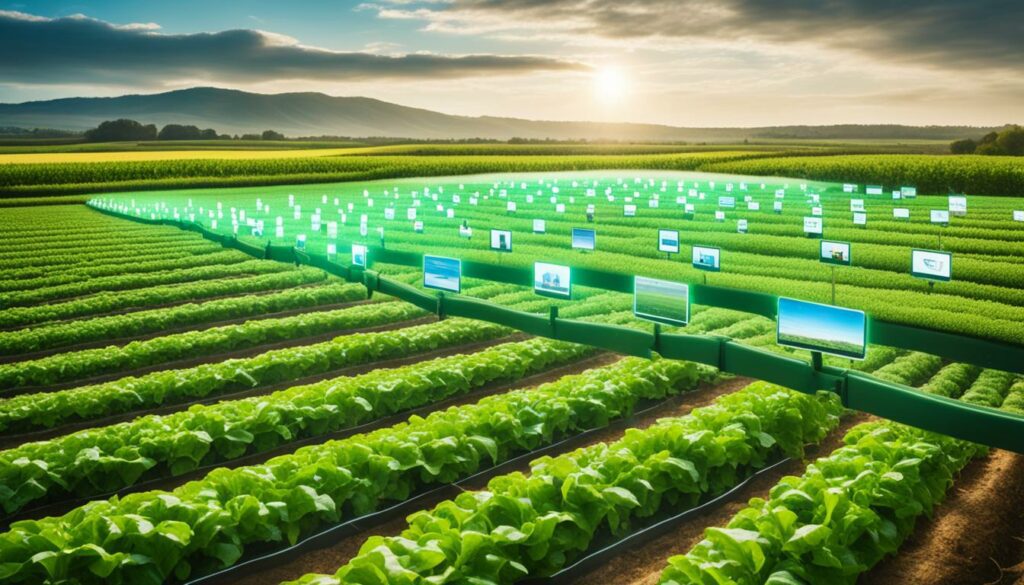
Working with local influencers who share our values can greatly increase the credibility of our farm. Their reviews help boost farm sales online.
SEO practices and good content can improve your website’s visibility. This means more people visit your site. And this often leads to better social media engagement.
Here is a quick look at how various activities affect engagement:
| Activity | Impact on Engagement | Outcome |
|---|---|---|
| Regularly Sharing Content | High | More people see and interact with your content |
| Responding to Queries | Moderate to High | It builds trust and keeps customers happy |
| Collaborating with Influencers | High | Your farm’s reputation grows, reaching more people |
| Using Hashtags | Moderate | Easier for people to find and engage with your content |
These activities show how improving engagement can lead to better farm sales. They highlight the value of engaging with our audience. As Mark Budia said, “Digital marketing helps farm businesses reach more people and stand out online.”
In South-South Nigeria, a case study shows social media’s impact on farm sales. Platforms such as WhatsApp and Instagram have cut down marketing costs. This has boosted farmers’ efficiency and sales.
Studies have found using social media, like WhatsApp and Instagram, lowers marketing costs. Farmers can use the money saved to improve their farms or expand their businesses. Also, these platforms help farmers talk directly with buyers. This makes customers trust the farmers more and engage with them better.
In South-South Nigeria, social media has upped the demand for farm products. This is mainly because mobile phones have made it easier to share information, even in remote areas. As a result, rural farmers’ living standards have improved. The technology acceptance model (TAM) shows how important it is that people find the internet useful and easy to use.
Theory says that by selling directly on social media, farmers can produce more and help their cooperatives. The study on the social media impact on farm sales in Nigeria uses both the TAM and cooperative theories. It focuses on how social media makes ads more efficient and reaches more people.
In some areas, ICT capabilities have made marketing agricultural products 57% better. The use of social media boosts both ads’ performance and sales. Interactivity, like online conversations, is key in linking farmers to their customers.
| Factors | Impact |
|---|---|
| Cost Reduction | Significant reduction in marketing expenses |
| Demand Increase | Higher demand for agricultural products |
| Market Efficiency | Enhanced efficiency and turnover |
| Living Standards | Improved living standards in rural areas |
| Interactivity | Boosts marketing and customer engagement |
Using social media well is key for farms today. It mixes great content with smart ads. This combo can grow your farm’s sales. Now, let’s look at how social media can up your earnings.
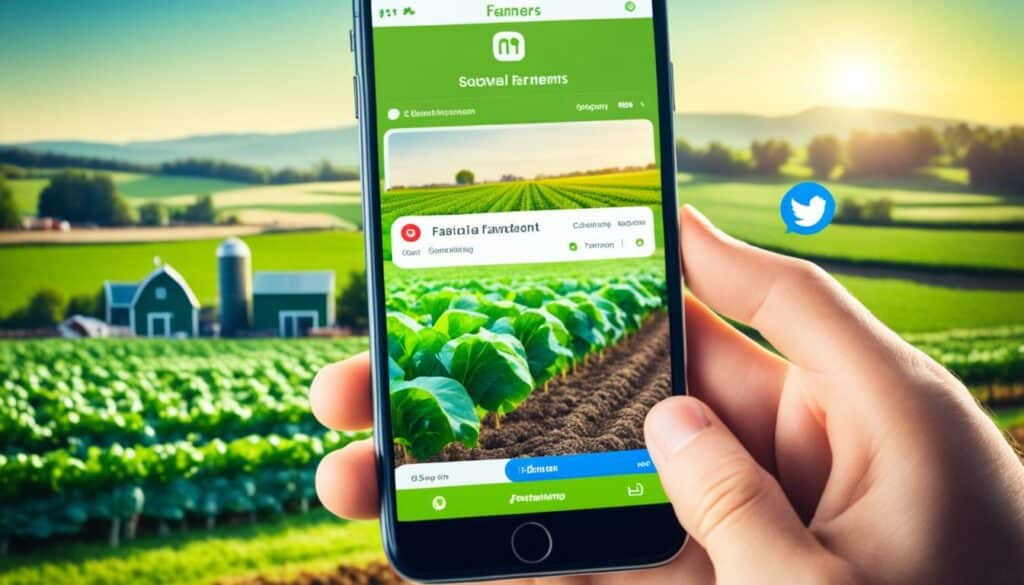
To make your social media work, plan your content well. This means knowing what your audience likes and what’s going on at your farm. Try focusing on these:
Sharing your customers’ content on Instagram can help a lot. It shows that others love your products too. Use hashtags like #supportlocal to make your farm more visible.
Targeted ads are a big deal for farms on social media. With Instagram’s huge audience and great ad options, you can reach the right people. Advertise to folks by their age, where they live, and more.
Organising your posts by theme helps keep your profile nice and interesting. This keeps your followers hooked. Lots of people buy things they see on social media. So, strategic ads can really drive up your sales.
Here is a comparative table illustrating the effectiveness of various social media strategies:
| Strategy | Benefit | Social Media Platform |
|---|---|---|
| User-Generated Content | Increases credibility | |
| Behind-the-Scenes Glimpses | Engages audience | Facebook, Instagram |
| Targeted Paid Ads | Custom audience reach | All Platforms |
| Hashtags | Expands audience | Instagram, Twitter |
Social media has changed how farms create their brand. It has led to more sales for farms. By showing a clear and real brand, farms can be remembered more and find new customers.
It’s key for farms to stick to their brand when selling online. Using the same logos, colours, and messages helps people know it’s the farm they love. This makes the farm more trusted and leads to more sales.
Farms can now talk to many different people online. They can pick who sees their posts based on what people like and do. With places like Facebook, farms can talk to a lot of people at once. For the younger crowd, there’s Instagram and TikTok, which are very popular.
Sticking to their brand helps farms get more people interested. This means making more sales and being more known in the market.
Rural farmers are finding success on social media. They are using it to reach more people and build important connections. This kind of marketing lets them reach customers far away. In the past, they would be limited to their local areas.
Platforms like Facebook, Twitter, and Instagram have huge numbers of users. Farmers can use them to find new market opportunities. This helps them sell more through social media. They are breaking the barriers that distance used to create.
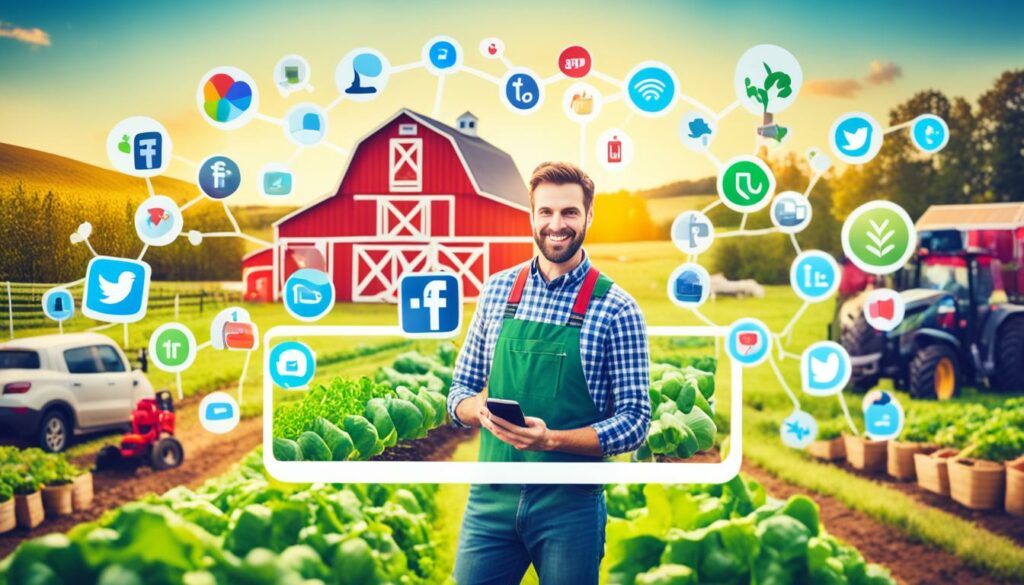
Social media lets rural farmers show their products to the world. Before, they could only advertise locally. With social media, they can find customers across the globe. This has led to a big increase in farm sales using social media.
Social media also helps farmers connect with each other. They can exchange useful information and ideas. This support and teamwork make their social media efforts even more successful. By working together, they learn how to sell their products better.
Additionally, social media is great for targeting ads to specific groups. This means farmers can market directly to people who are interested. This focused method saves money and brings better results. For example, in South-South Nigeria, using social media lowered the costs of selling and made more sales.
In the end, social media is a powerful tool for expanding market access. It also makes networking easier for farmers. By using social media, farmers can make their brands known. This leads to more sales and overall business growth.
Social media helps farmers learn what customers like. It makes their work more effective and successful. By checking what customers say online, farmers can change their products to better fit what people want.
Farmers use Facebook, Twitter, and Instagram to learn from customers. They share posts, stories, and do live videos to talk directly with people. This kind of interaction helps them better know what customers need.
Information from social media guides farmers in changing what they offer. Apps like WhatsApp and Instagram have made reaching customers cheaper. This means they can spend less on marketing and still make their products better liked.
About 57% of the boost in farming product sales comes from using technology. Social media is both good for the pocket and builds a true brand for farmers. It helps them stay in tune with what the market wants. It’s key for selling things in today’s farming world.
Through a smart use of social media, farmers can keep getting better. They match their efforts with what the market needs, boosting sales.
It’s vital to know how various age groups of farmers use social media. This helps in creating effective social media techniques for farm businesses. Young farmers, for instance, use platforms like Instagram and WhatsApp to learn and keep up with the news. They are quick to adopt new digital tools, which helps their farms earn more through social media.
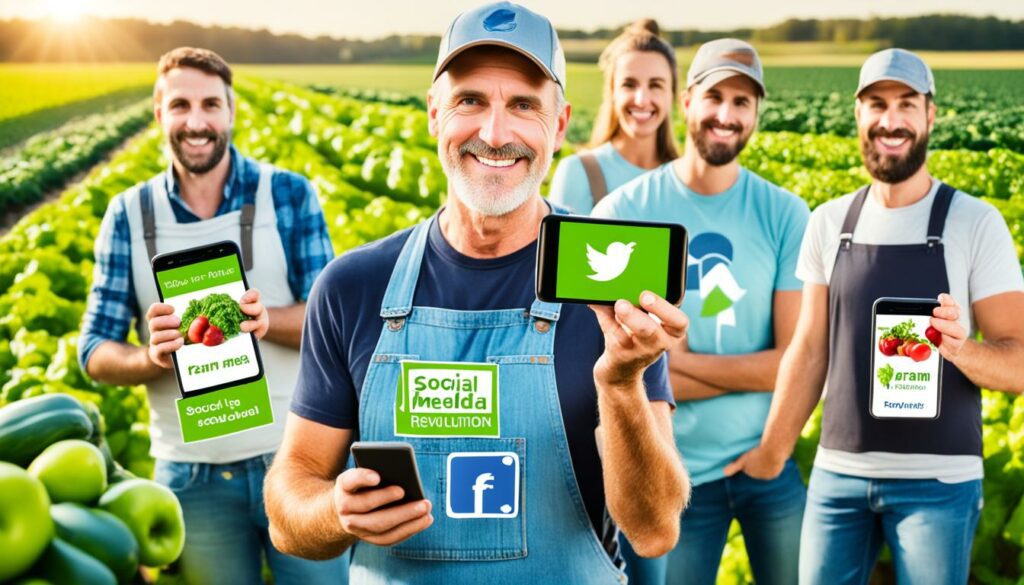
Studies show that 97% of farmers under 45 use their phones to go online. They’re more likely to use social media for farming. Some apps they often use include:
On the other hand, older farmers might not use social media as much. They’re more into traditional marketing, like face-to-face talks and ads. So, using social media effectively depends on the age of the farmer.
This shows the importance of boosting farm revenue through social media with different plans for different ages.
| Metric | Younger Farmers | Older Farmers |
|---|---|---|
| Internet Access via Phones | 97% | Varied |
| Use of News Apps | 71% | Lower |
| Use of Messaging Apps | 70% | Lower |
| Engagement with Educational Content | High | Lower |
Teaching older farmers how to use social media well could close the gap. Offering something for all ages is key. This way, these social media techniques for farm businesses can truly benefit everyone. This means more income for the farmers.
Joining social media with old marketing methods has big benefits for farms. It mixes the fast, wide reach of online sites with the reliable face of old tools. This creates a strong marketing mix for farms.
This mix benefits from both new and old tools. Online platforms can reach many people fast, while things like printed ads and local shows feel more familiar. This way, social media ads match different people’s likes.
Connecting social media with old ways boosts how much farms are seen and heard. Online, they can show off their stuff and talk with people instantly. Meanwhile, the old tricks spread these messages more widely. This mix makes farming more profitable and keeps more people interested.
Social media has changed how farms sell their products, playing a big role in marketing. In South-South Nigeria, farmers are using apps like WhatsApp and Instagram to sell more and save money. Through these platforms, they are spending less on marketing yet selling more farm goods.
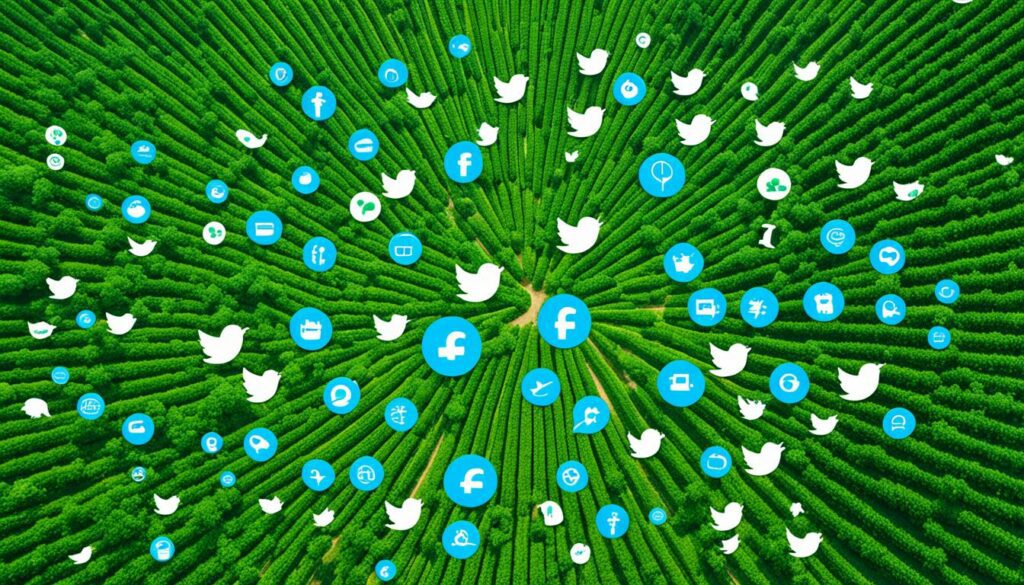
Studies show that using social media makes sharing info and marketing better. 46% of farmers use it for work every week, and 69% use it for fun. This shows the big effect social media can have on selling farm products.
Research in Kenya and Iran also shows social media is great for marketing and sharing knowledge. In Kenya, there’s a strong link between how much farmers interact on social media and how well their ads do. And in Iran, using tech for marketing has improved sales by 57%. These results match what we’ve seen in Nigeria.
Young and older farmers alike are jumping on the internet, especially through their phones. Facebook is the most popular, and YouTube is trusted for news. However, TikTok isn’t as trusted for getting information.
This data proves how important social media is for farm sales. With the right social media use, farmers can see their sales grow a lot.
| Statistic | Percentage |
|---|---|
| Farmers using social media for business work weekly | 46% |
| Farmers accessing social media weekly for personal use | 69% |
| Farmers under 45 years accessing internet via phones | 97% |
| Most frequented social media platform by farmers | |
| Most trusted platform for information and news | YouTube |
| Least trusted platform for information | TikTok |
In conclusion, using social media well is crucial for selling more in farming. With these insights from various places, it’s clear how important social media is for farm sales. By using it smartly, farmers everywhere can grow their business and work more efficiently.
Social media platforms, such as WhatsApp and Instagram, are key in boosting farm sales. They lower marketing costs and help reach more people, making them priceless in places like Nigeria. Using social media improves how efficiently farms sell their products by reaching customers directly and enhancing ads.
The Technology Acceptance Model (TAM) shows why it’s key to see the benefit and ease of using web tools for farmers. When the Theory of Agricultural Marketing Cooperatives is added, it’s clear using these methods can bring big gains. Farmers who sell directly and create a strong brand on Facebook and Instagram boost trust. They’re seen as top sources for quality, local goods, helping sales.
Finally, social media changes farming by opening new markets, connecting with customers, and building brand trust. To get the most out of it, farmers should keep learning about the newest trends and methods. This way, they make the most of social media for their sales, leading to ongoing success and profits in farming.
Social media boosts farm sales by making marketing better, cutting costs, and driving up demand. Platforms like Facebook and Instagram are key. They help in increasing sales and turnover for farmers, especially seen in South-South Nigeria.
Using engaging content and focusing on platforms like Instagram works well. Facebook is great for building your brand. It is important to keep your branding and content plans consistent for these methods to succeed.
Facebook has a lot of users and lets farms target ads well. It’s good for showing what your farm is about through your page. This interaction helps to get more leads and sales.
Instagram brings out the beauty of farm products through photos and direct contact with followers. It is especially good at creating a personal connection with consumers. This connection boosts farm sales.
Social media marketing is not only effective but also affordable for farmers. It combines free tools and cheap ads for a good return on investment. This method can lead to significant sales growth.
Farmers like apps for news, email, messaging, and social media. Facebook, WhatsApp, and Instagram are among the top choices. These apps make it easy for farmers to stay active on social media, even when they’re out working.
Interacting with people online by sharing useful updates and answering their questions makes a big difference. It builds loyalty and strong ties with your audience, leading to better sales over time.
The case study in South-South Nigeria showed social media cuts costs and grows market demand for farmers. This led to a big increase in sales. The study proves that social media has a major impact on farm sales.
To improve sales, it’s key to plan your content, target ads well, post visually appealing content, and keep your branding strong. These steps make your farm more credible and attract more people.
Social media helps farms create a strong, recognisable brand image. By talking to their audience regularly and in a real way, farms can grow their customer base and sell more.
Rural farmers get access to bigger markets and connect with others in the industry through social media. It lets them sell to more people, even reaching global markets.
Farmers can check interactions and feedback on social media to understand what people like. This helps them offer products that meet customer needs, increasing sales success.
Yes, younger farmers use social media more for learning and news. Older farmers use it differently. This means different approaches are needed to help all farmers in the industry.
Integrating social media with traditional marketing helps reach more people effectively. It combines the best of both worlds for better promotion. This approach maximises impact.
Yes, using social media well can boost your farm’s visibility, engage customers, and open up new markets. It can lead to a huge increase in sales and the overall success of your farm.